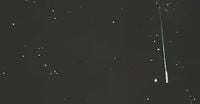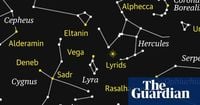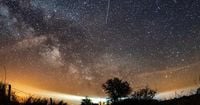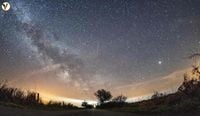Australian stargazers are in for a treat tonight as the Lyrid meteor shower reaches its peak, offering a dazzling display of shooting stars. According to NASA, those with a keen eye can expect to see anywhere from 10 to 20 meteors per hour as the annual shower lights up the night sky, particularly in the early hours of tomorrow morning.
Astrophysicist Michele Trenti from the University of Melbourne shared insights with NewsWire, indicating that while the meteor shower officially begins tonight, the optimal viewing window will be between 2 AM and 5 AM local time on April 22, 2025. So, if you're planning to step outside to gaze at the cosmos, a warm cup of tea and a bit of determination might enhance your experience.
To catch the most meteors, experts recommend finding a dark area away from the bright lights of the city. Viewers should look towards the northern to northeastern horizon and give their eyes around 30 minutes to adjust to the darkness, which will help in spotting the fainter meteors more clearly. “The Lyrids usually produce around 10 to 20 meteors per hour,” Professor Trenti explained. “It’s rare to see multiple at the same time, as each meteor is short-lived.”
The Lyrid meteor shower is one of the oldest recorded meteor showers, with observations dating back approximately 2,700 years. It occurs annually as Earth intersects with the debris trail left by Comet Thatcher, formally known as C/1861 G1 (Thatcher). As our planet passes through this trail, small particles from the comet disintegrate upon entering Earth’s atmosphere at speeds of up to 47 kilometers per second, creating bright streaks of light across the sky.
While the shower is typically best observed from the Northern Hemisphere, Australians can still enjoy the spectacle if they are patient and positioned in a dark location. The meteors are visible to the naked eye and do not require any special equipment, making it accessible for anyone interested in witnessing this celestial event.
For those who may miss the Lyrids, there’s good news: the next meteor shower, the Eta Aquarids, will peak on May 5-6, 2025. This event is known to be particularly spectacular, especially for viewers in the Southern Hemisphere, where it can produce up to 60 meteors per hour. “The Eta Aquarids will likely be a more spectacular sight than the Lyrids, but both are worth watching for the early risers,” Professor Trenti noted.
The Lyrid meteor shower is not only a beautiful natural phenomenon but also a reminder of our connection to the universe. As the meteors streak across the sky, they offer a moment of wonder and reflection for those lucky enough to witness them. Whether you're a seasoned astronomer or a casual observer, tonight presents a fantastic opportunity to step outside and gaze at the stars.
As the clock ticks towards the early hours of April 22, prepare to embrace the night sky. Grab a blanket, find a quiet spot, and take a moment to appreciate the beauty of the cosmos. The Lyrids are a reminder that nature has its own way of captivating us, and tonight, it’s putting on a show just for you.









